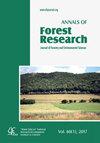Simulated annealing in feature selection approach for modeling aboveground carbon stock at the transition between Brazilian Savanna and Atlantic Forest biomes
IF 1.7
3区 农林科学
Q2 FORESTRY
引用次数: 1
Abstract
Forest ecosystems are important in the carbon storage process. Thus, the objective was to investigate the effectiveness of the Simulated Annealing meta-heuristic analysis for selecting variables to maximize the accuracy of the aboveground carbon prediction at the tree level. We used data from uneven-aged forests located in the Rio Grande Basin - Minas Gerais, Brazil, where 227 trees had their carbon stock measured. The classic Spurr linear model, stepwise linear regression and pan-tropical coverage, Random Forest (RF), and the hybrid SARF method (Simulated Annealing and Random Forest) were used to estimate the carbon stock from the selection of variables for the different compartments of the tree (total, stem, branch, and leaf). The SARF consisted of the metaheuristic to select the variables to be used in the RF. These methods were evaluated by the root mean square error (RMSE), coefficient of determination (R²), and residual graph. As a result, the pan-tropical equation demonstrated superior performance than the Spurr model due to its greater homogeneity of residues. The stepwise technique reduced the number of variables and the error of the estimates, mainly for the validation set. SARF showed better adjustments than RF, as it reduced in on average 99.2% of the number of variables and 9% of the error of estimates considering all compartments. In general, variables such as volume, basic wood density, canopy projection area, diameter at 0%, diameter at breast height, height, and latitude contributed strongly to the carbon independent of the tree compartment. Among the methods, SARF is an alternative to the traditional method, as it can extract accurate information from a large data set.巴西草原和大西洋森林生物群落过渡期地上碳储量建模的特征选择方法中的模拟退火
森林生态系统在碳储存过程中非常重要。因此,目的是研究模拟退火元启发式分析在选择变量方面的有效性,以最大限度地提高树木层面地上碳预测的准确性。我们使用了位于巴西米纳斯吉拉斯的格兰德河流域的不均匀老化森林的数据,在那里测量了227棵树的碳储量。使用经典的Spurr线性模型、逐步线性回归和泛热带覆盖率、随机森林(RF)和混合SARF方法(模拟退火和随机森林),通过选择树木不同分区(总、茎、枝和叶)的变量来估计碳储量。SARF由元启发式方法组成,用于选择要在RF中使用的变量。这些方法通过均方根误差(RMSE)、决定系数(R²)和残差图进行评估。因此,泛热带方程表现出比Spurr模型更好的性能,因为它具有更大的残差均匀性。逐步技术减少了变量的数量和估计的误差,主要是针对验证集。SARF显示出比RF更好的调整,因为考虑到所有隔间,它平均减少了99.2%的变量数量和9%的估计误差。一般来说,体积、基本木材密度、树冠投影面积、0%直径、乳高直径、高度和纬度等变量对碳的贡献很大,与树室无关。在这些方法中,SARF是传统方法的替代方法,因为它可以从大型数据集中提取准确的信息。
本文章由计算机程序翻译,如有差异,请以英文原文为准。
求助全文
约1分钟内获得全文
求助全文
来源期刊

Annals of Forest Research
FORESTRY-
CiteScore
2.20
自引率
11.10%
发文量
11
审稿时长
12 weeks
期刊介绍:
Annals of Forest Research is a semestrial open access journal, which publishes research articles, research notes and critical review papers, exclusively in English, on topics dealing with forestry and environmental sciences. The journal promotes high scientific level articles, by following international editorial conventions and by applying a peer-review selection process.
 求助内容:
求助内容: 应助结果提醒方式:
应助结果提醒方式:


